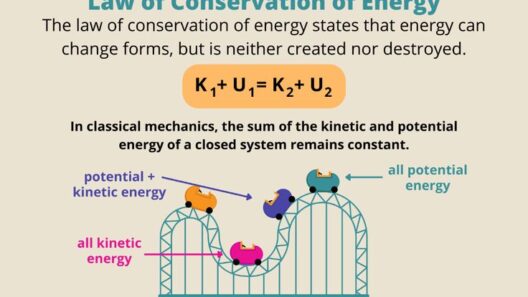The intricate relationship between gravity and the conservation of energy captivates both scientists and curious minds alike. Understanding this profound connection requires exploring the intricacies of gravitational forces and their implications on energy conservation. This exploration promises a shift in perspective, inviting readers to ponder the underlying principles governing our universe.
At the core of physics lies the universal law of gravitation, a fundamental principle describing the attractive force between masses. Sir Isaac Newton’s formulation elucidates how every particle in the universe exerts a gravitational pull on every other particle. This immutable law lays the groundwork for our understanding of celestial mechanics, influencing not only planetary orbits but also the very energy dynamics within various systems.
Gravity is often perceived merely as a force that pulls objects towards one another. However, it can also be viewed as a critical player in the realm of energy conservation. Energy exists in various forms—kinetic, potential, thermal, and so forth—and gravity is indispensable in the transformation between these forms. Potential energy, defined as energy possessed by an object due to its position in a gravitational field, is particularly noteworthy.
To illustrate, envision a boulder perched precariously on a cliff. The boulder possesses gravitational potential energy relative to its position above the ground. If it were allowed to roll down the cliff, this potential energy would be converted into kinetic energy as the boulder accelerates downward. The total mechanical energy—the sum of potential and kinetic energy—remains constant in an ideal, frictionless scenario, as dictated by the law of conservation of energy. This principle posits that energy cannot be created or destroyed, only transformed from one form to another.
Delving deeper into this phenomenon, one must consider the implications of gravitational fields on energy systems. These fields manifest in diverse forms, from the subtle pull of terrestrial gravity affecting our daily lives to the grand, sweeping forces governing the motion of planets and stars. In each instance, gravitational interaction orchestrates the ebb and flow of energy throughout the cosmos.
In more complex systems, such as the Earth itself, gravitational forces are integral to processes like the water cycle. As water evaporates from bodies of water, it ascends into the atmosphere, converting thermal energy into potential energy. Once the vapor condenses and precipitates back to the surface, this potential energy morphs into kinetic energy, driving streams and rivers while powering ecosystems dependent on water flow. Thus, gravity’s role extends far beyond the attraction between masses; it is a vital component in the dynamic fluctuations of energy within our environment.
Furthermore, gravity’s influence is also observable in celestial phenomena. In astrophysics, gravitational potential energy plays a crucial role in the life cycle of stars and planets. For instance, during the formation of a star, immense clouds of gas and dust collapse under their gravitational attraction. As the material condenses, gravitational potential energy converts into heat, igniting nuclear fusion—a transformation that fuels the star’s brilliance for billions of years. This transformation exemplifies gravity’s pivotal role in energy conservation on a cosmic scale.
Moreover, black holes represent the most extreme manifestation of gravity. Once massive stars exhaust their nuclear fuel, their gravitational pull can become so potent that not even light can escape. The energy associated with material falling into a black hole is formidable, demonstrating another layer of energy transformation under the influence of gravity. As matter spirals inward, it inevitably contributes to the release of energy in the form of radiation, further underscoring gravity’s foundational role in the energy fabric of the universe.
As we navigate the challenges of climate change, understanding the interplay between gravity and the conservation of energy is paramount. Human activities, such as the burning of fossil fuels, disrupt the natural energy balance, leading to catastrophic environmental consequences. By appreciating how gravity orchestrates energy flows, we can better comprehend the urgency of transitioning to sustainable energy sources that harmonize with these natural forces.
Renewable energy technologies, such as hydropower, harness gravitational energy by utilizing the potential of water stored in elevated reservoirs. As water flows downward, it drives turbines that generate electricity, a seamless blend of gravitational force and energy conservation principles at work. This integration reflects a deeper understanding of how we can align our energy production methods with the undeniable laws of nature.
As scientific inquiry continues to delve into the depths of gravity and energy dynamics, new avenues for innovation emerge. Exploration of advanced gravitational wave research could unveil further intricacies between cosmic phenomena and energy conservation. These futuristic concepts not only pique curiosity but also inspire a reimagining of how humanity can coexist with natural laws, cultivating a more sustainable and harmonious relationship with our planet.
In summation, the interplay between gravity and the conservation of energy offers a profound perspective on the mechanics of our universe. From the gravitational dance of celestial bodies to the water cycle sustaining life on Earth, gravity is an omnipresent force that governs energy transformations. Recognizing this relationship prompts an appreciation for the delicate balance of natural systems and the need for sustainable practices. As scientists continue to unravel the mysteries of gravity, society stands to gain not only knowledge but also a renewed sense of responsibility toward preserving our planet for future generations.








